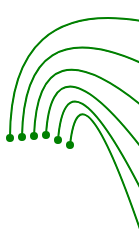The use of AI (artificial intelligence) and machine learning (ML) is mandatory when large multidimensional data sets are to be processed and classified together and their behaviour is to be predicted for the future. Often the goal is to detect deviations from the determined statistical characteristics of the data, so-called anomalies.
Meanwhile there is an unmanageable abundance of procedures from AI, mainly neural networks, which were already intensively analysed in the eighties and nineties. The distinction between supervised and unsupervised learning is still valid, see Bishop and Kohonen's literature on this subject under the menu item “Further information” in “Books & Papers”.
In principle, there is a problem of “overlearning” if the conditions do not match, such as net structure, net size and the amount of pattern set to be learned. This applies to both biological neural networks and artificial neural networks. The article by H. Uzan & I. Kanter: “Biological learning curves outperform existing ones in artificial intelligence algorithms” shows that the biological model has a higher performance compared to algorithms of AI. The structural complexity of real neural networks is the reason for this.
Today we have a large number of methods from AI and ML, also for time series analysis, available. For the time being, we refer to the homepage www.tokeya.de and to the menu item “Further information”, otherwise a more comprehensive presentation would go beyond the scope of this report.
In the narrative context of the last point, there is the advantage that the neural networks known from AI are structurally able to process the relevant data faster, simpler and more comprehensively than is the case with conventional NN by means of some changes in the calculation calculus for complex and hypercomplex numbers without further ado, see the book “Complex-valued Neural Networks” by A. Hirose: https://www.springer.com/de/book/9783642276316.


 English
English  Deutsch
Deutsch